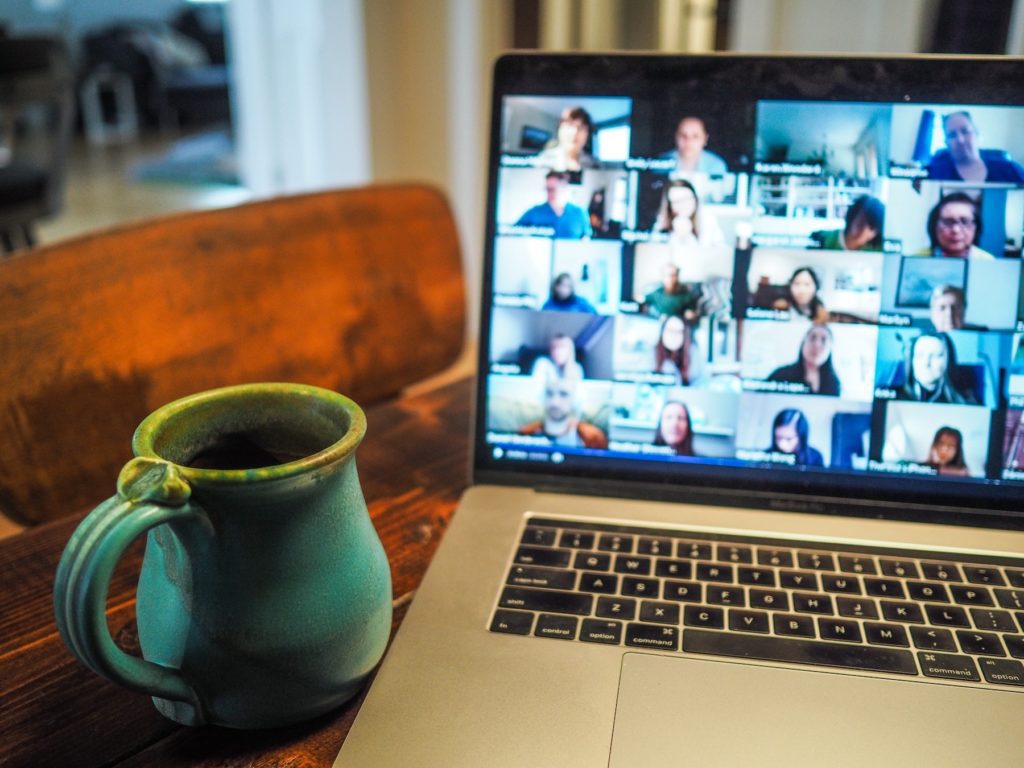
Many of us have been experiencing a chronic condition since early into the pandemic: Zoom fatigue. It’s growing worse.
Last November, Psychiatric Times published an article, “A Neuropsychological Exploration of Zoom Fatigue.”
Bottom line: it’s real.
18 months ago, I had barely Zoomed. Now I use Zoom as a verb. I nominate “Zoom fatigue” as the next code in the DSM (Diagnostic and Statistical Manual of Mental Disorders).
The past two Saturdays I attended great six-hour workshops over Zoom. The events were well designed and attracted great people. I learned a lot. And, at the end of each, all I could was flop on the couch. Zoom fatigue.
I’m not bashing Zoom. It has been a godsend. I’ve used it to learn so much this year.
But on Saturday, I started searching for the science behind my fatigue. Was it just me?
I found fascinating material on why Zoom tires our brains. I cite the articles below. Here, I’ll distill what I learned through my own experience. Then, I’ll offer a few home-brewed suggestions about what we can do to renew ourselves.
Your brain on Zoom: a personal perspective
Time delays. I’m getting used to those small time-lapses between people’s lips and their voices or between sending and receiving messages. Many of us don’t have the best internet connections so we’ve learned to tolerate this. But even a millisecond gap in what we hear makes our job of listening to a conversation harder. Our brain has to jump over the little chasms in connection to keep tracking on the conversation. We’re making it work harder.
Fewer rewards. Psychologists remind us the brain likes rewards. I speak, you smile back, I’m rewarded. We have a lot fewer rewards for our efforts on Zoom. We can’t see the subtle responses coming from the sixteen little boxed heads facing us on the screen. Making a positively brilliant comment on Zoom, only to experience a three-second delay before being acknowledged, does not reward. Neither does having someone unintentionally jump in and speak over the top of you. Fewer rewards mean more fatigue.
Eye contact. People reward each other and build relationships through eye contact. You know the problem of trying to look at the camera and the screen at the same time on Zoom. We’re probably creating a new race of beings who can only look at each other obliquely.

The stare factor. There’s a name for this Zoom phenomenon: “constant gaze.” Outside of those personal growth workshops in the eighties, most people do not stare into each other’s eyes from three feet away for any period of time. I tested this at dinner with my husband. We looked at each other, then at the beans, then at the dogs, then the rice, all the while paying attention to each other. The conversation was enjoyable. Staring at faces can be exhausting.
Blinks. The research I read was based on life pre-Zoom, but the idea translates. Apparently, we often blink less when working intently at the computer. I’m sure prolonged staring at little boxes contributes to eye strain.
Multitasking. I know: it tires us without being very effective. But, you’re more enlightened than me if you never multitask on Zoom. (We knew that anyway.) The longer I sit on Zoom the more likely I am to be guilty of multitasking. Am I not supposed to read and respond to the message: “Shall I pick up Syrian food for supper?” when it might lead to a yummy, work-free dinner?
Tech glitches. My poor brain. How long have I sat trying to sustain my attention as someone struggles to resolve a tech glitch. (Or I do). My brain hangs out on pause as if it’s stuck in rush hour traffic on I-5. Exhausting.
Watching your own face. Apparently, Zoom discovered this drives some people crazy. Now, you can adjust Zoom so that you don’t have to see your own face. Personally, I’ve come to like my cheekbones more than I thought, even as I worry about the bags under my eyes. Which reminds me of another thing:
Lighting. Lots of tips are available for lighting your face for Zoom, but how many of us want to turn a simple conversation into a photoshoot? Still, I strain watching friends whose faces look like ghosts in the penumbra. It’s not their fault. It’s 11:30 pm in England and they’re in their jammies.
Less mobile. This is my personal bugaboo. Using the phone, I can pay attention and sweep the floor. I even listen more. Physical activity can keep us energized, The science indicates that “physical activity is associated with about a 40% reduced risk of fatigue.” Turn that around and it doesn’t look good for Zoom.
Weird backdrops, I know that shot of Hawaii is prettier than what’s behind you in your office, but it’s disconcerting to see your head merging into the waves. And I’m sure it’s disconcerting to see all the stuff I have behind me in my studio. I’ve started using a plain paper screen. Admittedly, I’ve enjoyed seeing people’s homes with their pets, kids, art, and toys. But a plain backdrop can also be soothing.
I could add more, but I’ll refer you at the end to some interesting articles. In the meantime:

How to avoid Zoom fatigue
Some of the suggestions you’ve heard before. I’ll start with the obvious and then give you a few I’ve invented.
UPS. (Use the phone, silly.) You’ve seen my face. It’s just the two of us. Can we talk on the phone so I can sweep the floor and listen better to you?
Fewer meetings. I cry uncle. I love the webinars I’ve attended. But I need to limit my chair-sitting Zoom time. I like to listen to recordings so I can move about.
Less multi-tasking. Notice I don’t say none. (I’m not that hypocritical.) If you break to read that message from your husband or feed the dog, your sin is minor. Acknowledge it, take a breath, and return to the conversation.
Better design. I’ve had the opportunity to see a few Zoom-design pros in action. What I observe are more activities that engage people, through the chat, breakout groups, exercises, games, and breaks. The pros also facilitate conversations so that extremely-extroverted-Eleanor or I-haven’t -spoken-to-anyone-in-months-Harry don’t monopolize or excessively prolong the conversation.
Shorter sessions. My in-person classes used to go for ninety minutes without a break. I think our endurance is half that on Zoom.
Turn off the video. Could we take a break from the video? Maybe just leave the speaker on view? Or let ME turn off my video? Hey, I love you even if you don’t see me. But my back will love you more if I can be liberated from this chair. I need to move. I’ll be listening
Now for my homemade brew:
Play more. This is big. Play interrupts the hypnotic trance we can fall into. With a little experimenting, you can play games and use Zoom for improv. And you’ll wake people up before they become hypnotized. Play reminds us that we are people and not cyborgs. Here’s a simple game: Invite folks to rename themselves on Zoom (easy to do) to the name of their favorite historical figure, super-hero or alter ego. Then, talk from that voice. Who knows, I might be more useful to the conversation as Dorothy Day, Mother Teresa, or Rosa Parks.
Bounce it up. For Christmas, I was given a rebounder, (mini-trampoline). Now I sometimes bounce during calls. (Video off). I can look at the computer and still feel like I have a body! It relaxes me. Yoga’s not so good because it’s harder to see the screen. With audio off, I sometimes chant under my breath. It helps my lungs and no one knows!.
Eye breaks. Help your eyes relax. They’re on the frontline for Zoom fatigue. Rub your hands very quickly together and then place your palms over your eyes to help relax them. Or remind yourself to gently stare off in the distance every so often. The researchers say you need twenty seconds of staring at a distance at least 20 feet away every 20 minutes. With Zoom, I need to look away more often. Every three minutes?

Draw and doodle. A friend once caught me in the act and asked, “Are you drawing us?” Guilty! I felt so embarrassed. I think the up and down of my eyes was distracting. Next time, I’ll kill the video. But really, what’s so bad about doodling and drawing? People do it all the time during in-person lectures. Drawing is my favorite way to stay focused and relaxed. Plus, staring at Zoom has taught me that faces are fascinating. You don’t need to know that I’ve pinned your image on the screen and am drawing your nose. But, truthfully, I love your nose. I promise.
Now to you. What’s your secret stash of Zoom survival skills? I’d love to learn with you.
Here are some interesting articles.
From Psychiatric Times: https://www.psychiatrictimes.com/view/psychological-exploration-zoom-fatigue
About blink rates: https://pupilbox.com/blogs/blog/why-does-blink-rate-slow-computer-use; from HBR: https://hbr.org/2020/04/how-to-combat-zoom-fatigue












6 Responses
Thank you Sally for the tips and reminders. I play solitaire when I’m listening on zoom.
Thanks for this, Sally!
I find that typing what other people are saying helps me stay with the conversation.
I’ve done that for years when coaching storytellers on the phone. When coaching via Zoom, I find that the challenge is to be able to type with less looking at my fingers or at what I’m typing. In general, I just let what I’m typing go un-looked-at (a challenge, because I’m not a great typist). Usually I’m making a recording for my client, so I know that, in the rare case when I need refer to what was said but can’t decipher my notes, I can check on the recording.
Typing can help, too, when I attending a meeting for my own sake. But there’s always the danger that other people will assume I’m multi-tasking. Actually, I’m “multi-streaming,” in the sense that I’m devoting an extra channel to the listening process.
Thanks for bringing all this up; I’ve never articulated much of this before!
Oh, I just noticed that link to Psychiatric Times didn’t work somehow. Here’s the bare URL:
https://www.psychiatrictimes.com/view/psychological-exploration-zoom-fatigue
Thanks so much Doug for your comments about typing – useful idea that I will try – and also a corrected link. I’ll correct the link on the blog. Take care, Sally
Before very recent times, how often would you actually see yourself while talking to another person or persons? It’s such a strange phenomenon. Folks in the few Zoom groups I participate in always want to see each other, so I comply. Since I almost never look in the mirror during my non-virtual life, Zoom is especially jarring. I caught the tail-end of an NPR show last month where the interviewee claimed that old-fashioned non-visual phone calls are actually more engaging, intimate and satisfying than Facetime, Skype, Zoom, etc. (findings based on research). Always love your topics and insights.